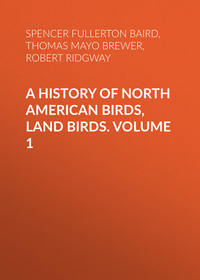 полная версия
полная версияA History of North American Birds, Land Birds. Volume 2
Afterwards, in his journey near the Mississippi, Wilson observed the same birds frequenting the borders of rivers and ponds, and feeding on the reptiles found in those waters. They were close attendants upon the cow-yards, and were more solitary, but much less shy and suspicious, than the common Crow. This species was also observed by Wilson in Cape May County, New Jersey, and in the regions bordering on the Schuylkill and the Delaware, near Philadelphia, during the shad and herring fishing, or from March till June.
During the breeding-season they were observed to separate into pairs, and to build their nests in tall trees near the sea or the river shore. One of their nests was in a tall wood at Great Egg Harbor, and they were presumed to have four or five young at a time.
In the District of Columbia, Dr. Coues found the Fish Crow to be an abundant resident throughout the year, less wary and suspicious than the common Crow, and more confined to the borders of rivers. It was generally confounded with C. americanus.
The Fish Crow appears to have received, even if it does not merit, an exemption from the general unpopularity of its race. It is generally believed to be at least a harmless species, and in its destruction of reptiles and vermin to be even beneficial. This belief, we apprehend, is for the most part well founded. Yet Mr. Audubon accuses these Crows of entering gardens and feeding upon the best fruits. He also states that, near Charleston, they commit such depredations upon the ripe figs, and become so troublesome generally in the gardens, that it is often found necessary to station a man near the fig-trees to shoot and destroy them.
The Fish Crow is confined either to the maritime districts or to the banks of rivers branching from them. Audubon states that they ascend the Delaware to quite a distance, and that some breed in New Jersey every year, but that all retire to the South on the approach of cold weather. Some go up the Mississippi to the distance of five hundred miles, but return to the seashore in the winter. In East Florida, where they were very abundant, Mr. Audubon found them breeding in February, in South Carolina on the 20th of March, and in New Jersey a month later. On the St. John’s River, during February, he saw them in flocks of several hundred, but all seemed mated and to move in pairs, sailing high in the air in the manner of Ravens. After these aerial excursions the whole body descended to the water’s edge to feed. When their fishing was over, they would alight in flocks on the live-oaks near the shore, and there keep up their gabbling, while they plumed themselves, for hours. They then returned to their fishing-grounds, where they remained until near sunset, moving into the interior to great distances, to roost on the loblolly-pines. These retreats were made in silence, but their return to the sea-shore in the early morning was made with noisy and lively demonstrations. They were then to be seen among the bays, rivers, salt ponds, and marshes, searching for small fry, and picking up any garbage they might find.
Mr. Audubon also accuses them of robbing other birds of their eggs and young. This was especially observed on the Florida Keys, where they even dared to plunder the nests of the Cormorants and White Ibis. They feed largely on the small crabs called fiddlers, which they pursue and easily capture in their burrows. He has also seen them attack and pursue small Gulls and Terns, and attempt to make them disgorge the fish they have caught; but as the flight of the latter is swifter, they are frequently unsuccessful in these attempts at robbery. This Crow can catch living fish with considerable dexterity, but cannot feed while on the wing.
During the winter and early spring, Mr. Audubon states that these birds feed on various kinds of berries, especially those of the Ilex cassina and of the common holly, and those of the exotic tallow-tree, now so common near Charleston (Stillingia sebifera). In January and February these trees are much resorted to by the Crows, who greedily devour their white and oily seeds.
Mr. Audubon found these birds breeding generally on moderate-sized trees of the loblolly-pine, building their nests towards the extremities of the branches, about twenty feet from the ground. The nests are smaller than those of the Crow, and are built of sticks, lined with dry grasses and moss, and neatly finished with fine fibrous roots. The eggs are five or six in number, and resemble those of the Crow, but are smaller.
Two eggs of this species, from St. Simon’s Island, measure, one 1.50 in length by 1.10 in breadth, the other 1.52 by 1.09. Their ground-color is a light blue with a slight greenish tinge, marked over the entire egg with small blotches of a light brown. An egg from Great Egg Harbor, obtained by Wilson, from the old Peale Museum, and which may be a faded specimen, has no tinge of blue or green, but a ground of pinkish-gray, marked with smaller blotches and cloudings of dark drab. It measures 1.46 inches in length by one inch in breadth.
Genus PICICORVUS, BonapPicicorvus, Bonaparte, Consp. Av. 1850, 384. (Type, Corvus columbianus, Wils.)
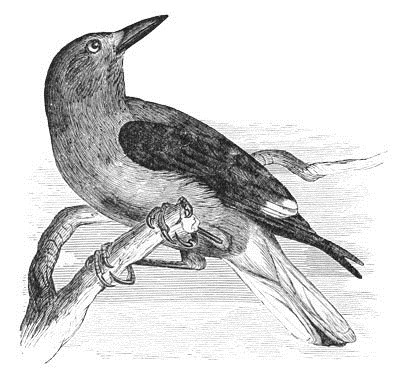
Picicorvus columbianus.
Gen. Char. Leaden-gray color, with black wings and tail. Bill longer than the head, considerably longer than the tarsus, attenuated, slightly decurved; tip without notch. Culmen and commissure curved; gonys straight or slightly concave, as long as the tarsi. Nostrils circular, completely covered by a full tuft of incumbent white bristly feathers. Tail much shorter than the wings, nearly even or slightly rounded. Wings pointed, reaching to the tip of tail. Third, fourth, and fifth quills longest. Tarsi short, scarcely longer than the middle toe, the hind toe and claw very large, reaching nearly to the middle of the middle claw, the lateral toe little shorter. A row of small scales on the middle of the sides of tarsus. Color of the single species leaden-gray, with black wings and tail.

Picicorvus columbianus.
4461
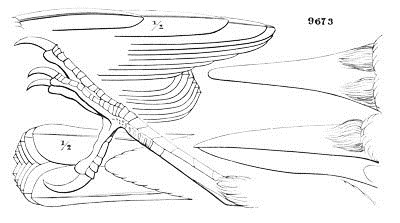
Nucifraga caryocatactes.
9673
This genus is so similar to Nucifraga as to be hardly separable; the principal difference being in the slender and more decurved and attenuated bill, with a slightly concave, instead of convex, culmen, and plain instead of spotted plumage. The differences of form are expressed by the accompanying outlines of the generic features of the two. But one species is known, this being peculiar to Western North America.
Picicorvus columbianus, BonapCLARKE’S CROWCorvus columbianus, Wilson, Am. Orn. III, 1811, 29, pl. xx.—Bon. Obs. Wilson, 1824, No. 38.—Ib. Syn. 1828, 57.—Nuttall, I, 1832, 218. Nucifraga columbiana, Aud. Orn. Biog. IV, 1838, 459, pl. ccclxii.—Ib. Syn. 1839, 156.—Ib. Birds Am. IV, 1842, 127, pl. ccxxxv.—Bon. List, 1838.—Nuttall, Man. I, (2d ed.,) 251. Picicorvus columbianus, Bonap. Consp. 1850, 384.—Newberry, P. R. R. Rep. VI, IV, 1837, 83.—Baird, Birds N. Am. 1858, 573.—Lord, Pr. R. A. Inst. IV, 121 (British Columbia).—Dall & Bannister, Trans. Chicago Acad. I, 1869, 286.—Cooper, Orn. Cal. 1, 1870, 289. “Corvus megonyx, Wagler.”
Sp. Char. Tail rounded or moderately graduated, the closed wings reaching nearly to its tip. Fourth quill longest; second considerably shorter than the sixth. General color bluish-ash, changing on the nasal feathers, the forehead, sides of head (especially around the eye), and chin, to white. The wings, including their inner surface, greenish-black, the secondaries and tertials, except the innermost, broadly tipped with white; tail white, the inner web of the fifth feather and the whole of the sixth, with the upper tail-coverts, greenish-black. The axillars plumbeous-black. Bill and feet black. Young similar in color, without additional markings of any kind. The gonys, however, convex, and the bill generally more like that of the Jays. Length of male (fresh), 12.00; wing, 7.00; tail, 4.30; tarsus, 1.20.
Hab. From Rocky Mountains to Pacific. East to Fort Kearney, north to Sitka, south to Arizona.
Habits. Clarke’s Crow was first met with by the parties composing the celebrated exploring party to the Rocky Mountains under the direction of Lewis and Clarke. It was described by Wilson in 1811, who was informed by individuals belonging to the expedition that these birds were found inhabiting the shores of the Columbia and the adjacent country in great numbers, frequenting the rivers and sea-shore, and that it seemed to have all the noisy and gregarious habits of the common Crow of Europe.
In his account of this species, Mr. Nuttall states that during his journey westward in the month of July, he first observed individuals of this bird in a small grove of pines on the borders of Bear River, near where it falls into Lake Timpanagos. This was at a height of about seven thousand feet above the sea level, and in the 42d parallel. Their habits appeared to him to correspond with those of the Nutcrackers of Europe.
He afterwards saw a considerable flock of the young birds early in August, in a lofty ravine near the Three Buttes, a remarkable isolated mountain group about forty miles west of the Lewis River. They appeared somewhat shy, and were scattered through a grove of aspens, flying, with a slight chatter, from the tops of bushes and trees, to the ground. He was of the opinion that this species never descends below the mountain plains, but that it has a constant predilection for the pine forests.
Mr. Townsend afterwards found this species abundant on the Blue Mountains of Oregon. He describes its flight as very unlike that of a Crow, being performed in jerks, in the manner of a Woodpecker. At times, when sitting, it is said to keep up a constant scream, in a very harsh and grating voice, and in an unvaried and prolonged tone. He states that it breeds in very high pine-trees, and that he did not meet with it within five hundred miles of the Columbia River.
Mr. Ridgway found this species one of the most abundant birds of the pine forests of the Sierra Nevada. East of this range it was also met with, though only in smaller numbers, in the cedar and piñon woods of the East Humboldt Mountains. He adds that it is a bird so curiously striking as at once to attract attention. It bears but very little resemblance to any bird of its family, and in its general appearance, flight, and notes approaches so nearly to the Woodpeckers as to be usually known to the settlers as a bird of that tribe.
He further remarks that its flight much resembles that of Melanerpes torquatus, and, as it alights from the top of a tall dead tree, and sits quietly gazing around, it might readily be mistaken for one of the Picidæ. He describes them as being very active in their movements, now flying from a tree to the ground to pick up some article of food, now examining the excavations of an old dead stump or snag, or, on being approached, as flying up and alighting upon the extreme summit of a tree, out of gunshot. It is a very noisy bird, and its notes are harsh and discordant, though less so than are those of the Steller’s Jay, which is generally seen in the same localities. Its usual note is a harsh guttural churr-churr, generally uttered when two or more alight on the same tree. Occasionally an individual takes up a peculiar piping strain, which is immediately answered by all the others in the neighborhood, thus awakening the echoes of the surrounding solitude with their discordant cries. In regard to its nest he can give no positive information, but thinks that they breed in cavities in old dead trees and stumps, having found a nest in such a situation in the East Humboldt Mountains, which he thinks belonged to a pair of these birds which were flying about, and seen to enter this cavity.
Dr. Newberry, in his Report on the zoölogy of his route, states that he found this species rather common along a large portion of it, and was thus enabled to study its habits at leisure. He found it strictly confined to the highlands and mountains, never, where he saw it, descending to a lower altitude than about four thousand feet. On the other hand, while crossing the Cascade Mountains at the line of perpetual snow, seven thousand feet above the sea-level, he has seen this bird, in company with the Melanerpes torquatus, flying over the snow-covered peaks three thousand feet above him.
He first met with this bird on the spur of the Sierra Nevada, near Lassen’s Butte, and found it constantly, when in high and timbered regions, from there to the Columbia. He describes its habits as a compound, in about equal parts of those of the Jays and of the Woodpeckers. Its cry he speaks of as particularly harsh and disagreeable, something like that of Steller’s Jay, but louder and more discordant. It seems to combine the shrewdness with all the curiosity of the Jays and Crows, and from its shyness is a very difficult bird to shoot, the Doctor never being able to get directly within killing distance of one of them, but only obtaining specimens by concealing himself and waiting for them to approach him. Apparently from excess of caution, it almost invariably alights on a dry tree. Even when going to a living tree for its food, it always flies first into a dry one, if one is near, to reconnoitre, and, if the coast is clear, it begins to feed. At the first movement of an intruder, without uttering a note, it puts a safe distance between itself and its enemy.
The food of this bird, at the time when Dr. Newberry visited its haunts, consisted exclusively of the seeds of the yellow pine (P. ponderosa), in dislodging which from the cones the bird displays great dexterity. Both Maximilian’s Jay and Steller’s Jay were, at that time, feeding on the same seeds, but not so exclusively.
Dr. Suckley obtained a specimen of this bird as far east as Milk River, in Nebraska, about two hundred miles east of the Rocky Mountains.
In crossing the Cascade Mountains, in 1853, Dr. Cooper found these birds quite abundant on the banks of the Yakima River, and from thence north wherever there were trees of the long-leaved pine, the seeds of which were its principal food. On returning to Vancouver during the severe cold weather of the following January, these birds appeared there in considerable numbers. At no other season of the year has he met with them west of the Cascade Mountains, and believes these migrations westward are only made in the severest weather. They extend eastward throughout Washington Territory, as Dr. Cooper has shot them at Fort Laramie, and met with a straggling pair even as far east as Fort Kearney. Dr. Cooper has never known these birds to eat anything except seeds and berries. They rarely descend to the ground, and never frequent river-banks, or other places, for fish or carrion. They may be seen on the tops of trees extracting seeds from cones, hanging head downwards, like a Chickadee. Dr. Cooper has observed this bird pecking at dead bark, in quest of insects. When feeding they are very shy, flying off, if approached, to a great distance before alighting. They are not known to visit the Coast Mountains south of San Francisco, but abound in the Rocky Mountains throughout our limits.
Mr. J. K. Lord notes the arrival of this species at Fort Colville, in May, in large flocks. They were hopping busily from branch to branch, amidst pine-trees.
The statement made to Wilson that this species frequents rivers and seashores, and his inference that its formidable claws indicated that they feed on living animals, is controverted by Mr. Lord. They never frequent river-banks, never by any chance eat fish, and never capture any living thing. Their habits are strictly arboreal, and their food the seeds of pine-trees. These noisy seed-hunters use their formidable claws to enable them to hang on to the pine cones while they are extracting the seed, which they are obliged to get out from under scaly coverings. For this nature has given them feet and claws that serve the purpose of hands, and a powerful bill, like a small crowbar. The cone must be steadied when they pry it open, or it would snap and fall. One foot clasps it, and the powerful claws hold it firmly. The other foot, encircling a branch, supports the bird in every possible position, the long grasping claws being equal to any emergency. The cone is thus fixed, and the seeds are forced out from under the scales. Mr. Lord collected a large packet of seeds of the Abies douglassi from the crops of these birds.
On their arrival they assemble in immense flocks, and the noise they make he describes as a most discordant, continuous, grating clatter, intensified at times into a perfect shriek. These assemblies last about a week, after which they separate in pairs.
A nest of this bird was found by Mr. Lord in the top of a lofty pine at least two hundred feet high,—felled in cutting the boundary line. By chance he discovered the nest, about which the old birds were hovering, leaving no doubt of its identity. This nest was very large and composed of fir twigs, bits of bark, the leaves of the pine, fine root-fibres, with small pieces of moss, and gray lichens mixed carelessly with the other materials. It was shallow and round, and presented a large extent of surface beyond the margins of the hollow containing the eggs. The eggs were in fragments, much like the eggs of Steller’s Jay in color, but of a lighter shade of bluish-green. He thinks that their habit is to build in the very tallest pines.
Dr. Kennerly also met with this Crow west of Albuquerque, in New Mexico, in the thick pine woods skirting the eastern slope of the Rocky Mountains, where it was quite abundant. He rarely saw more than two or three together. None were met with after leaving the mountains.
A single specimen of this crow was obtained at Sitka, by Bischoff.
Genus GYMNOKITTA, Pr. MaxGymnorhinus, Pr. Max. Reise Nord. Amer. II, 1841, 21. (Type, G. cyanocephala.)
Gymnokitta, Pr. Max. “1850,” Gray.
Cyanocephalus, Bonap. “1842,” preoccupied in Botany.
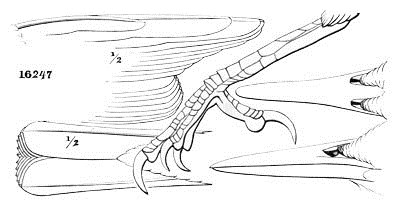
Gymnokitta cyanocephala.
16247
Gen. Char. Bill elongated, depressed, shorter than the tarsus, longer than the head, without notch, similar to that of Sturnella in shape. Culmen nearly straight; commissure curved; gonys ascending. Nostrils small, oval, entirely exposed, the bristly feathers at the base of the bill being very minute. Tail short, nearly even, much shorter than the pointed wings, which cover three fourths of the tail. Tarsi considerably longer than the middle toe. Color of the single species blue, most intense anteriorly; the throat streaked with white.
The bill in this genus is not unlike that of Sturnus and Sturnella, and conspicuous among Corvinæ by its uncovered nostrils.
Gymnokitta cyanocephala, Pr. MaxMAXIMILIAN’S JAYGymnorhinus cyanocephalus, Pr. Max., Reise in das innere Nord-Amerika, II, 1841, 21.—Ib. Voyage dans l’Am. du Nord, III, 1843, 296. Gymnokitta cyanocephala, “Pr. Max. 1850,” Bp. Conspectus, 1850, 382.—Cassin, Illust. I, VI, 1854, 165, pl. xxviii.—Newberry, Rep. P. R. R. VI, IV, 1857, 83.—Baird, Birds N. Am. 1858, 574.—Max. Cab. J. VI, 1858, 193.—Cooper, Orn. Cal. 1, 1870, 292. Psilorhinus cyanocephalus, Gray, Genera. Cyanocorax cassini, M’Call, Pr. A. N. Sc. V, June, 1851, 216.
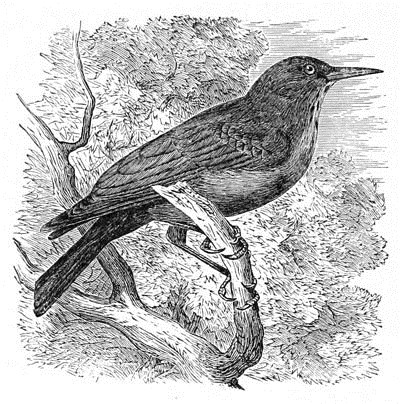
Gymnokitta cyanocephala.
Sp. Char. Wings considerably longer than the tail, and reaching to within an inch of its tip. Tail nearly even. General color dull blue, paler on the abdomen, the middle of which is tinged with ash; the head and neck of a much deeper and more intense blue, darker on the crown. Chin and forepart of the throat whitish, streaked with blue. Length, 10.00; wing, 5.90; tail, 4.50; tarsus, 1.50. Young bird not differing in markings.
Hab. Rocky Mountains of Colorado, to Cascade Mts. of California and Oregon. Not on the Pacific coast? South to New Mexico and Arizona.
The female is appreciably different from the male, both in size and plumage, being smaller, and of a light bluish-ash tint. This difference is readily appreciable when the birds are seen flying.
Habits. Maximilian’s Jay was discovered and first described by that eminent naturalist, Maximilian, Prince of Wied, in his book of travels in North America, published in 1841. Mr. Edward Kern, who was connected with Colonel Fremont’s exploring expedition in 1846, was the first to bring specimens of this interesting and remarkable bird to the notice of American naturalists, transmitting them to the Philadelphia Academy. The specimens procured by its discoverer were met with by him on Maria’s River, one of the tributaries of the Upper Missouri, in the extreme northern portion of our northwestern territory, a point much farther north than it has been met with by any other naturalist. As this species has since been seen in large numbers in New Mexico, it may be presumed to extend its movements over quite an extended area of distribution in the region of the Rocky Mountains.
According to the more recent observations of Mr. Ridgway, the Maximilian Jay inhabits exclusively the nut-pine and cedar woods on the interior mountain ranges, and is one of the most characteristic birds of those regions. This species he states to be eminently gregarious, even breeding in colonies, and in winter congregating in flocks, sometimes of thousands. Ever restless and in motion, as it moves it is constantly uttering its curious, querulous notes. It is a very conspicuous bird, and is one well worthy of particular attention. Its blue color is the only thing suggestive of its affinity to the Jay. All its habits are different, and its appearance is quite peculiar. It is as essentially migratory as the Ectopistes migratoria, its coming and its going being quite as sudden and uncertain. On one occasion, in visiting a nut-pine wood, Mr. Ridgway found it full of roving, noisy troops of these birds, but upon visiting the same locality the next day not one could be seen.
He also states that these birds are exceedingly early in their nesting, as he met with companies of fully fledged young flying about on the 21st of April. Near Carson City, April 20, 1868, he found these birds abundant among the scattered cedars and nut-pines on the lower slopes of the hills. They were in pairs, often three or four pairs in company.
The notes of this bird are both peculiar and curious. The usual ones are said to have some resemblance to the querulous wailings of the Screech Owl; but none, in his opinion, have any resemblance to the cry of the Catbird.
It flies very swiftly, but with a gentle floating motion, very much in the manner of the Robin. In its movements among the small cedars, it generally alighted upon the summit of a tree, and, quietly sitting there, would look about in the manner of the Picicorvus columbianus. In flying, it continually uttered a very peculiar querulous note, resembling very much one of the notes of the Magpie,—the peculiarly soft note of that bird uttered during the love-season, or when its nest is approached. In searching among the cedars, Mr. Ridgway found several of its nests. Nearly all had been deserted, and there were several families of fully fledged young flying about. One nest contained four fully feathered young. When these had been taken, and placed in a hat, they all jumped out, squalling vociferously. These nests were all saddled upon horizontal branches of cedars, and, except in their greater bulk, they closely resembled the nest of the eastern Blue Jay.
In autumn and in winter the large flocks of these birds, as they fly back and forth over the hills, present a very peculiar appearance. Their flight is then very swift.
Dr. Kennerly, in November, 1853, frequently saw large flocks of these birds between the Puebla of Laguna and the Sierra Madre, about a hundred miles west of Albuquerque, in New Mexico. They were found chiefly frequenting the watercourses, and when startled would circle around, rising higher above their heads, uttering their singular cries; then suddenly descending they would alight in the top of some tree on the adjoining cliffs. He compares its voice to that of the common Catbird.





